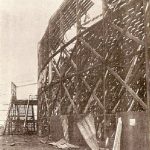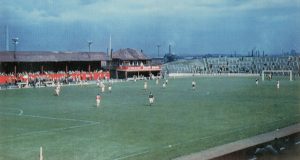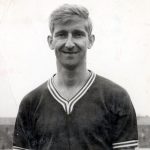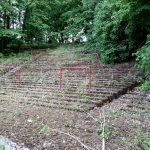Three Hampden Parks and two Cathkin Parks
It has always been difficult to talk of Cathkin Park without also referring to Hampden Park, and you can’t talk of either without involving the Hi Hi’s nearest neighbours, Queens Park FC.
Hampden nowadays may be unique, but between 1873 and 1903 there were no fewer than three Hampdens. The first was situated near Hampden Terrace, midway between Cathkin and the present-day Hampden Park. Built specially for the (as now) staunchly amateur Spiders, it featured the pavilion that was a central feature of many grounds at the time, rudimentary banking and not much else. Its life was short, as in 1883 the Cathcart Circle railway was driven through the site and the football club built Hampden no.2 – the ground that would, 20 years later, become Cathkin Park.
Queens Park soon outgrew the second Hampden. They were one of the biggest clubs of their day, and were keen to have a ground that could stage cup finals and internationals. Hampden no.2 hosted some such matches, but their new home at nearby Mount Florida allowed them to compete with the improving facilities at Ibrox and Parkhead. Hampden was huge. In 1937 a record 147,365 watched the Cup Final between Celtic and Aberdeen. The European record attendance for an international was set the same year, when 149,415 saw a Scotland v England game. Nowadays the capacity is a more modest 51,866, all-seated.
Third Lanark, meanwhile, had been formed in 1872 by members of the 3rd Lanarkshire Rifle Volunteers. Their first ground, Cathkin Park, was at Govanhill Park. In 1890, with Celtic, Rangers and eight other clubs, they were founder members of the Scottish Football League. When they were given the chance to move into Hampden Park no.2, they named it New Cathkin Park.
So, to recap: that’s a first, a second and a third Hampden Park, a Third Lanark, a Queens Park, a Cathkin Park and a New Cathkin Park. Pay attention, there’ll be a test at the end.
Pavilions
Back in the day, no Glasgow football ground was complete without a little house inside it for the players and officials to use. This seems to have been largely a Scottish thing – the most notable examples south of the border were at Fulham and Bradford, both grounds designed by the Scottish architect Archibald Leitch.
- first pavilion
- second pavilion
- Ibrox pavilion
Leitch was also heavily involved in the design of Ibrox, opened by Rangers in 1899. There too, the early ground featured a fine pavilion. But Leitch’s original design turned out to be a deathtrap. Rangers were very proud of their new wooden terracing and the resultant capacity of 75,000, but when a crowd of 68,114 attended a game between Scotland and England in 1902, a section collapsed and spectators were hurled many feet onto the street below. The wooden terraces were hastily replaced with solid earth banking, and Queens Park insisted that their new Hampden Park should feature terraces built in the same way.
- deathtrap
- the street below
Celtic Park, opened in 1892, had its own pavilion on the halfway line. Hampden also featured one, albeit sandwiched between two substantial stands. As for Third Lanark, when they moved from Cathkin to New Cathkin, they found a nice pavilion along with a two-storey brick built grandstand and embankments. But for reasons best known to themselves, they elected to knock them all down and start again.
New Cathkin Park
If pavilions were a notable feature of Scottish grounds, then so too were broad, sweeping terraces. Ibrox, Parkhead and Hampden had these in abundance: a seated stand on one touchline and a vast elliptical bowl were the norm, and Cathkin too followed this model. Later years brought refinements such as concrete steps and even roofs at the big three, but to its last days Cathkin remained true to cinder steps inside first wooden, then concrete nosings.
For a detailed look at Cathkin Park, see this excellent model from Moonfruit: www,footballmodels.moonfruit.com/#/cathkin-park/4516743833
The original main stand remained until 1964, and a barn-like cover stood on the banking opposite. The original terraces, once capable of holding 60,000, were by the end much reduced. But this was still a big arena and a visit today reinforces a sense of scale and openness.
The Hi-Hi
Hi-Hi is one of those nicknames – like Baggies, or Addicks – that no-one really knows the reason for. The explanations I have heard sound twee, so I won’t go there. They were also known as the Redcoats, which is better. Maybe it started off as Hi-de-Hi.
Whatever they were called, for most of their history the team were successful. Founder members of the Scottish Football Association, they spent much of their time in the top division and were champions in 1903-04, the first season at Cathkin Park. Jimmy Brownlie, their then goalkeeper, represented Scotland for a decade.
They won the Scottish Cup twice. In 1961 they finished third, in a season when they scored 100 goals. It was in this era that a record 45,544 people watched their Cup-tie with Rangers at Cathkin. The front line at that time – Jim Goodfellow, Dave Hilley, Alex Harley, Matt Gray and Joe McInnes – was one of the finest ever seen in Scotland.
Other notable players to wear the famous scarlet included Jimmy Mason, Jocky Robertson and Ally McLeod.
Mason, an inside forward, was at the club between 1936 and 1953, but guested in England – for Portsmouth, Charlton and Brentford – during World War Two. He played for Scotland seven times in the Thirties, and following his retirement ran a pub in Bridgeton. He died in 1971 on a flight to Prestwick Airport, on his way back from holiday.
Robertson, a mere 5’5” tall, played for Thirds between 1951 and 1964. He had injured both hands while a junior footballer, in an accident at the Edinburgh cardboard factory where he worked, yet was one of the very best Scottish goalkeepers of the Fifties. His finest hour came in the 1959 League Cup Final at Hampden, where he pulled off save after save to keep the Hi-Hi in a one-sided final against his boyhood heroes, Hearts.
- Mason
- Robertson
- McLeod
McLeod – who lived at Mount Florida after his family were bombed out of their Clydebank home – made his debut in 1947 at the age of just 16. A winger, he was nicknamed “Noddy” because of the action his head made when he ran. In his third game, against Hibs at Cathkin, the main stand caught fire when a oil stove was knocked over in the press box and the players had to rescue their clothes from the burning dressing rooms.
McLeod’s first spell with Thirds lasted until 1957 (he continued to turn out while on National Service) and he was then transferred to St Mirren for an impossible-to-refuse £8000, subsequently joining Blackburn where he played in the 1960 FA Cup final. He rejoined the Hi-Hi in 1964 from Hibs, making 24 appearances before playing out his career at Ayr.
McLeod was of course best known as a manager. Success at Ayr and Aberdeen led him, in 1977, to the Scotland job, where he secured qualification for the 1978 World Cup finals and a wholly undeserved reputation as a gobshite. Thirds, meanwhile, also had their share of decent bosses.
Best of them in the modern era was Bob Shankly. It’s always tempting to describe him as “Older brother of Bill”, but Bob was a great manager in his own right. After two good years at Cathkin – in which he led them to that 1959 Hampden final – he moved on to Dundee, taking them to a Cup Final and a European semi before succeeding Celtic-bound Jock Stein at Hibernian. Dry wit seems to have run in the Shankly family. “In the team photograph he’d be very careful about where he positioned you”, recalled former Scotland boss Craig Brown. “The nearer the middle the better. He used to come up to the guy on the end and say ‘You just sit there, son. A pair of scissor’s’ll soon get rid of you.’”
Shankly was succeeded at Thirds by former Rangers defender George Young. Young had won 12 domestic trophies at Ibrox, including the first ever domestic treble, and captained Scotland 48 times. He was known as “Corky” because of the lucky champagne cork he always carried. It is not recorded where he put it when he was on the pitch.
Young’s time at Cathkin was short. He resigned in spectacular fashion in 1962, walking out of the AGM with his backroom staff to the words of director Robert Martin, who also resigned – “Good luck to Thirds and God help them.” The reason for the unrest was one man – Bill Hiddleston.
Unsafe hands
Despite going out of business more than half a century ago, to this day Third Lanark remain one of the most written-about clubs in Scottish football. There are any number of excellent articles about them both online and in print. It’s hard to put your finger on why, and equally hard to find a fresh angle on what are, mostly, a set of indisputable facts.
The answer to both these questions lies in the sad story of their final years. Mostly the blame is laid at the feet of Hiddleston. A glass merchant, the egotistical Hiddleston was first involved with Thirds in the mid-Fifties, on one occasion appointing himself manager (the team lost 6-1 to Morton in his first game). He appears to have waged a campaign to gain sole control of the club – which its unusual cartel-based management structure allowed him to do – and then to run it in a singularly disastrous fashion.
The generally accepted reason is that he was a crook. This theory is supported by the fact that following the club’s collapse, a Board of Trade investigation fined four of Hiddleston’s “directors” under the Companies Acts, describing his operation as an “inefficient and unscrupulous one-man business”. Hiddleston only escaped punishment because he died in Blackpool of a heart attack in 1967. As ex-player Tony Connell recalls, “I’ll never forget one of my former team-mates remarking that we never knew he had a heart in the first place.”
Some recent commentators have noted that despite what appears to have been blatant corruption and asset-stripping, Hiddleston did invest in the club – the new main stand, opened in 1962, was a fine building and deserved to have been used for longer then just five years. But given that it was the stand’s contractors who had the club liquidated, it seems the investment was more symbolic than actual. Opinion is divided, too, on the widely-believed theory that Hiddleston engineered Thirds’ decline in order to sell the ground for housing. These too are muddy waters as a development company did eventually buy the land, only for Glasgow Corporation to designate Cathkin as open space and compulsorily purchase it.
There is, however, plenty of evidence for Hiddleston being criminal, incompetent, or both. There are numerous anecdotes about his penurious habits. Thirds’ last manager, Bobby Shearer, was obliged to raid the turnstiles for coppers to pay his team. Visiting sides would bring their own lightbulbs and soap. On one occasion, Hiddleston had the players throwing water on the pitch so that the next day’s game would be frozen off. He made them carry the fruit machines out of the social club and hide them behind the pavilion because the tax inspector was coming. He even used apprentices to re-tile the dressing room bath to save money (they tiled over the plughole and caused a flood).
And if it’s possible to see these episodes as blackly humorous, the same can’t be said of the incident in which a Thirds player suffered a terrible compund fracture in a game against Clydebank. Hiddleston instructed team-mate Mike Jackson to accompany the injured man to hospital and ensure his jersey was not cut off, because the club only had one set of shirts. The unfortunate victim suffered agony but Hiddleston’s jersey remained intact.
Whatever Hiddleston’s motives, the outcome is beyond dispute. Third Lanark’s last game was played on 28 April 1967, a 5-1 defeat at Dumbarton. The last match at Cathkin three days previously had seen Thirds draw 3-3 with old rivals Queens Park. Given the affection with which the club was (and still is) regarded, the way in which the football community turned their back and allowed this to happen speaks volumes, both about Hiddleston’s standing and the unwillingness of others to do business with him.
Cathkin Park today
Following the collapse, Cathkin Park went through a slow process of decline. Over the years the Council removed what buildings remained – the main stand was destroyed by fire in the Seventies – and landscaped the site into a public park. The pitch remains, and is still used: so too does most of the terracing, although trees and shrubs cover much of it.
Partly because of this, Thirds never faded from public consciousness in the way some vanished clubs do. Cathkin’s proximity to Hampden guarantees a steady stream of visitors to supplement the local people who use the park. And some callers do more than play football, walk their dogs or imagine the ground as it was. They come here to maintain the perimeter wall and the terraces, keeping their memories alive and commemorating Cathkin Park and what it once meant.
- pitch
- terracing
- trees
- landscaped
- perimeter
- ghosts
Rebuilding Third Lanark
There is still a Third Lanark FC in Glasgow, playing in the Greater Glasgow Amateur League. They currently share Vale of Clyde’s Fullarton Park in Tollcross, but in April 2017 announced ambitious plans to return to Cathkin, rejuvenate the site and – by adding changing rooms, additional pitches and community facilities – once more place it at the centre of the community.
It’s an intriguing vision, and such a perfect squaring of the circle deserves to succeed. But for now, the old place slumbers on – left to the dog-walkers, the kickabout players, the Cup Final passers-by and the ghosts of the past.

























